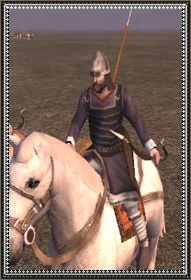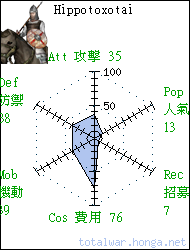|
Hippotoxotai
|

Views 查看: 137
|
Class and category 兵種 |
missile cavalry
|
| Soldier 兵員數量 |
ere_light_ha, 40, 0, 0.75
Soldier model, Number of the soldier, Number of extras, Mass of the men
兵種或其乘員, 數量, 附屬單位數量, 衝擊質量
|
| Mount 騎乘座騎 |
bc heavy horse, elephant -4, camel -4
Type of animal or vehicle ridden on and its effect
座騎或載具種類及其影響效果
|
| Engine and Ship 攻城器與戰船 |
Siege engine or ship
攻城器具或船隻種類
|
| Attributes 特殊屬性 |
sea_faring, hide_forest, hardy, can_withdraw, can_formed_charge
A miscellanious list of attributes and abilities the unit may have
兵種特殊屬性或能力
|
| Formation 陣形 |
2, 3, 3, 6, 2, square
|
| Hit points 生命值 |
1, 0
Hit points of man, Hit points of mount or attached animal (Ridden horses and camels do not have separate hit points)
生命值, 附屬單位生命值(座騎無額外的生命值)
|
| Primary weapon 主武器 |
5, 6, arrow_ha_l, 150, 48, missile, missile_mechanical, piercing, none, 25, 1, no
Attack factor, Charging bonus factor, Missile type, Range of missile, Missile ammunition, Weapon type, Tech type, Damage type, Sound type, Min delay between attacks, Skeleton compensation factor in melee, Weapon attributes
攻擊力, 衝鋒加成, 遠程彈藥種類, 射程距離, 彈藥數, 武器類型, 攻擊方式, 傷害類型, 聲響, 攻擊間隔, 動作補償, 武器特殊屬性
|
| Secondary weapon 副武器 |
4, 5, no, 0, 0, melee, melee_blade, piercing, spear, 25, 1, no
Attack factor, Charging bonus factor, Missile type, Range of missile, Missile ammunition, Weapon type, Tech type, Damage type, Sound type, Min delay between attacks, Skeleton compensation factor in melee, Weapon attributes
攻擊力, 衝鋒加成, 遠程彈藥種類, 射程距離, 彈藥數, 武器類型, 攻擊方式, 傷害類型, 聲響, 攻擊間隔, 動作補償, 武器特殊屬性
|
| Primary armour 主防禦 |
3, 5, 4, leather
Armour factor, Defensive skill, Shield factor, Sound type
護甲防禦值, 格檔技巧, 盾牌, 聲響
|
| Secondary armour 副防禦 |
0, 0, flesh
Animal's or vehicle's armour factor, Defensive skill, Shield factor, Sound type
附屬單位之護甲防禦值, 格擋技巧, 盾牌, 聲響
|
| Heat and ground effect 氣候地形影響 |
0, 0, -1, -3, 0
Extra fatigue suffered by the unit in hot climates, Scrub, Sand, Forest, Snow
炎熱對疲勞度的影響, 灌木叢地形影響, 沙地, 森林, 雪地
|
| Mental 士氣 |
7, low, untrained
Morale, Discipline, Training
士氣, 紀律, 訓練
|
| Cost 招募成本 |
1, 755, 355, 89, 54, 755
Number of turns to build, Cost of unit to construct, Cost of upkeep, Cost of upgrading weapons, Cost of upgrading armour, Cost for custom battles, Limit in custom battle, Cost for punish
徵召回合, 招募費, 維持費, 升級武器, 升級盔甲, 自訂戰役, 多於幾隊, 懲罰金額
|
| Unit Description 兵種描述 |
|
|
 |
 Hippotoxotai were one of the reasons why Eastern Romans could defend their lands from the invaders from the East as well as from the West. According to Praecepta Militaria, Nikephoros Phokas’ diatribe on military matters, they were inseperable part of the cavalry, screening and defending the heavier Kataphraktoi or Klibanarioi or Proniarioi. According to that book, each archer (either on horse or on foot) should be equipped with two bows, 4 strings and two quivers, one with 60 arrows and the second with 40. In addition to those the archers would receive extra 50 arrows from the armory of “Imperial arrows”. Besides the bow, which was their prime weapon, the horse archers would have to be equipped with swords or axes, in case they would have to fight in a melee as well as slings. Hippotoxotai formed the backbone of the cavalry of the Medieval/Eastern Roman Empire, also known as Byzantine. Many times they would turn the tide of victory in favor of the E. Roman forces. Hippotoxotai would be the mounted gentry and lower nobility most of the times, but also former enemies, who now fought for the empire, rather than against it. In the following excrept an attempt was made to present how they were used in all aspects of the battle, even in the march to battle. In later years, hippotoxotai were simply mercs, mainly Turkish then Armenian ones to even Mongols, who were used by the Empire in its effort to recapture the balkans (after reclaiming Konstantinoupolis in 1261 by the first Palaiologos emperor its final Palaiologoi dynasty)./n/nHistorically, the reason why the Empire survived for so many centuries was its ability to learn from its enemies and adapt to the situation as it occurred. Using Horsearchers was absolutely essential that the empire would survive, especially when faced by horse archer factions. The range of the bow that the Romans used was around 300 meters, while it was very deadly in closer range. The horsearchers (hippotoxotai) main abilities according to Medieval Roman military doctrine was speed, precision, and ability to sustain the maximum amount of damage upon the desired target. All the Medieval Roman military connoisseurs who went on to write intonated many times over that the continuous practice and drilling of the archers was essential for them to retain their edge against the enemies of the empire. The Medieval Roman army would use both the “Mongol” and the “Mediterranean” bowing methods./n/nThe evolution of the E. Roman hippotoxotai was continuous and so was the importance given to them. Hippotoxotai, Trapezitai, and the heavy horse were the essential army of the Medieval/Eastern Roman Empire. Even according to “Praecepta militaria” written by Nikephoros Phokas, the infantry was secondary, expected to hold the line, while the cavalry would win the battle. The Hippotoxotai had taken the composite bow from the Huns. The saddle they used, using the stirrup that the Sarmatians developed, was specifically that of the Avars along with many of the tactics in battle which will be analysed below. Having enough warhorses was always a priority for the Medieval Roman state. In fact it would always try to maintain adequate supplies of them, even buying off enough from the surrounding “barbarian” tribes./n/nThe tactics in the “Praecepta militaria” concerning the use of the Hippotoxotai are the following: They would be used as “Prokoursatores”, a noble term for raiders if there was one. This would be a mixed force of chosen lancers and horse archers 300-500 in number able to perform behind enemy lines reconnaisance in force and quick retreat. It was a veteran force raised in the frontier where raids and skirmishes were daily. Most of the times they would split up in smaller groups and re-assemble behind enemy lines. There they would loot the country side, capture prisoners and bring them back in the camp for questioning. They would also set ambuscades, nightly ones if possible, or would harass the enemy, trying to disrupt their supply lines./n/nIn regular cavalry it w
Hippotoxotai were one of the reasons why Eastern Romans could defend their lands from the invaders from the East as well as from the West. According to Praecepta Militaria, Nikephoros Phokas’ diatribe on military matters, they were inseperable part of the cavalry, screening and defending the heavier Kataphraktoi or Klibanarioi or Proniarioi. According to that book, each archer (either on horse or on foot) should be equipped with two bows, 4 strings and two quivers, one with 60 arrows and the second with 40. In addition to those the archers would receive extra 50 arrows from the armory of “Imperial arrows”. Besides the bow, which was their prime weapon, the horse archers would have to be equipped with swords or axes, in case they would have to fight in a melee as well as slings. Hippotoxotai formed the backbone of the cavalry of the Medieval/Eastern Roman Empire, also known as Byzantine. Many times they would turn the tide of victory in favor of the E. Roman forces. Hippotoxotai would be the mounted gentry and lower nobility most of the times, but also former enemies, who now fought for the empire, rather than against it. In the following excrept an attempt was made to present how they were used in all aspects of the battle, even in the march to battle. In later years, hippotoxotai were simply mercs, mainly Turkish then Armenian ones to even Mongols, who were used by the Empire in its effort to recapture the balkans (after reclaiming Konstantinoupolis in 1261 by the first Palaiologos emperor its final Palaiologoi dynasty)./n/nHistorically, the reason why the Empire survived for so many centuries was its ability to learn from its enemies and adapt to the situation as it occurred. Using Horsearchers was absolutely essential that the empire would survive, especially when faced by horse archer factions. The range of the bow that the Romans used was around 300 meters, while it was very deadly in closer range. The horsearchers (hippotoxotai) main abilities according to Medieval Roman military doctrine was speed, precision, and ability to sustain the maximum amount of damage upon the desired target. All the Medieval Roman military connoisseurs who went on to write intonated many times over that the continuous practice and drilling of the archers was essential for them to retain their edge against the enemies of the empire. The Medieval Roman army would use both the “Mongol” and the “Mediterranean” bowing methods./n/nThe evolution of the E. Roman hippotoxotai was continuous and so was the importance given to them. Hippotoxotai, Trapezitai, and the heavy horse were the essential army of the Medieval/Eastern Roman Empire. Even according to “Praecepta militaria” written by Nikephoros Phokas, the infantry was secondary, expected to hold the line, while the cavalry would win the battle. The Hippotoxotai had taken the composite bow from the Huns. The saddle they used, using the stirrup that the Sarmatians developed, was specifically that of the Avars along with many of the tactics in battle which will be analysed below. Having enough warhorses was always a priority for the Medieval Roman state. In fact it would always try to maintain adequate supplies of them, even buying off enough from the surrounding “barbarian” tribes./n/nThe tactics in the “Praecepta militaria” concerning the use of the Hippotoxotai are the following: They would be used as “Prokoursatores”, a noble term for raiders if there was one. This would be a mixed force of chosen lancers and horse archers 300-500 in number able to perform behind enemy lines reconnaisance in force and quick retreat. It was a veteran force raised in the frontier where raids and skirmishes were daily. Most of the times they would split up in smaller groups and re-assemble behind enemy lines. There they would loot the country side, capture prisoners and bring them back in the camp for questioning. They would also set ambuscades, nightly ones if possible, or would harass the enemy, trying to disrupt their supply lines./n/nIn regular cavalry it w
|
|